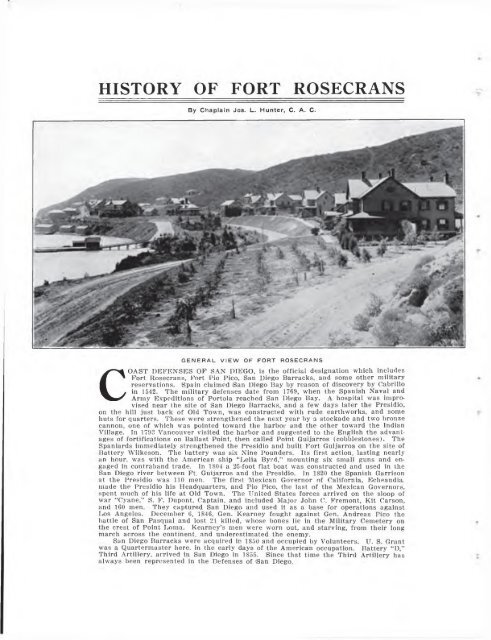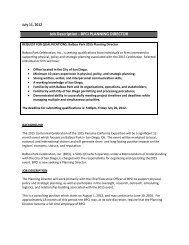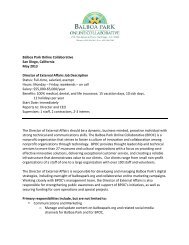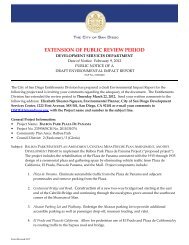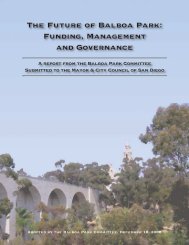Army and Navy Review 1915 Panama-California Edition - Balboa Park
Army and Navy Review 1915 Panama-California Edition - Balboa Park
Army and Navy Review 1915 Panama-California Edition - Balboa Park
Create successful ePaper yourself
Turn your PDF publications into a flip-book with our unique Google optimized e-Paper software.
H ISTORY OF FORT ROSECRANS<br />
By Chaplain Jos. L. Hunter, C. A. C.<br />
GEN ER AL VIE W OF FORT ROSECRANS<br />
COAST D E F EN SE S OF SAN DIEGO, is the official designation which includes<br />
Fort Rosecrans, Fort Pio Pico, San Diego Barracks, <strong>and</strong> some other m ilitary<br />
reservations. Spain claimed San Diego Bay by reason of discovery by Cabrillo<br />
in 1542. The m ilitary defenses date from 1769, when the Spanish Naval <strong>and</strong><br />
<strong>Army</strong> Expeditions of Portola reached San Diego Bay. A hospital was improvised<br />
near the site of San Diego Barracks, <strong>and</strong> a few days later the Presidio,<br />
on the hill just back of Old Town, was constructed with rude earthworks, <strong>and</strong> some<br />
huts for quarters. These were strengthened the next year by a stockade <strong>and</strong> two bronze<br />
cannon, one of which was pointed toward the harbor <strong>and</strong> the other toward the Indian<br />
Village. In 1793 Vancouver visited the harbor <strong>and</strong> suggested to the English the advantages<br />
of fortifications on Ballast Point, then called Point Guijarros (cobblestones). The<br />
Spaniards immediately strengthened the Presidio <strong>and</strong> built Fort Guijarros on the site of<br />
Battery W ilkeson. The battery was six Nine Pounders. Its first action, lasting nearly<br />
an hour, was w ith the American ship “Lelia Byrd,” m ounting six small guns <strong>and</strong> engaged<br />
in contrab<strong>and</strong> trade. In 1S04 a 25-foot flat boat was constructed <strong>and</strong> used in the<br />
San Diego river between Ft. Guijarros <strong>and</strong> the Presidio. In 1820 the Spanish Garrison<br />
at the Presidio was 110 men. The first. Mexican Governor of <strong>California</strong>, Eclie<strong>and</strong>ia,<br />
made the Presidio his Headquarters, <strong>and</strong> Pio Pico, the last of the Mexican Governors,<br />
spent much of his life at Old Town. The United States forces arrived on the sloop of<br />
war “Cyane,” S. F. Dupont, Captain, <strong>and</strong> included M ajor John C. Fremont, K it Carson,<br />
<strong>and</strong> 160 men. They captured San Diego <strong>and</strong> used it as a base for operations against<br />
Dos Angeles. December 6, 1846, Gen. Kearney fought against Gen. Andreas Pico the<br />
battle of San Pasqual <strong>and</strong> lost 21 killed, whose bones lie in the M ilitary Cemetery on<br />
the crest of Point Loma. Kearney’s men were worn out, <strong>and</strong> starving, from their long<br />
march across the continent, <strong>and</strong> underestimated the enemy.<br />
San Diego Barracks were acquired in 1850 <strong>and</strong> occupied by Volunteers. U. S. Grant<br />
was a Quartermaster here, in the early days of the American occupation. Battery “D,”<br />
Third Artillery, arrived in San Diego in 1855. Since that time the Third Artillery has<br />
always been represented in the Defenses of San Diego.


